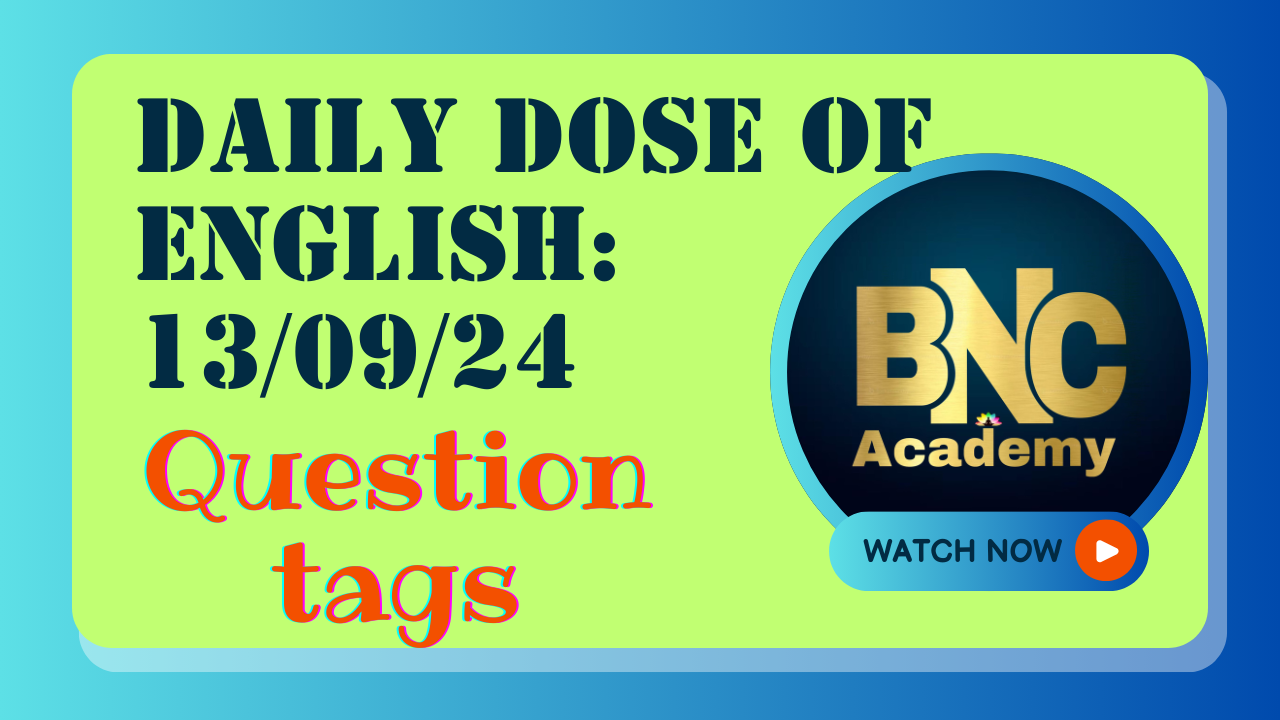Mastering Question Tags: Importance, Rules, and Practice Exercises for students and competitive exam aspirants.

In spoken and written English, question tags play a crucial role in keeping conversations fluid and engaging. Whether confirming a statement or seeking agreement, question tags help turn statements into questions, making communication smoother and more interactive. In this blog post, we will explore what question tags are, why they are important, the rules governing their usage, and provide practice exercises with explanations.
What are Question Tags?
A question tag is a short question added to the end of a statement. It is used when the speaker expects the listener to confirm the information or agree with the statement made. For example:
- You’re coming to the meeting, aren’t you?
In this sentence, “Aren’t you” is the question tag, which prompts the listener to confirm whether the information in the statement is correct.
Importance of Question Tags
Question tags serve several important functions in communication:
- Encourage Interaction: By using a question tag, the speaker invites a response, making the conversation more interactive and engaging.
- Check Understanding: They allow the speaker to confirm whether the listener has understood or agrees with the statement.
- Soften Statements: Question tags can make a statement less forceful or direct, making the tone more polite.
- Build Confidence: They are commonly used to seek reassurance or agreement, helping the speaker feel more confident in their assertions.
Rules for Using Question Tags
While question tags are simple in concept, using them correctly requires following specific rules:
- Positive Statement – Negative Tag: If the statement is positive, the question tag should be negative.
- Example: She is a teacher, isn’t she?
- Negative Statement – Positive Tag: If the statement is negative, the question tag should be positive.
- Example: He isn’t coming, is he?
- Matching Auxiliary Verbs: The auxiliary verb in the main sentence (e.g., is, are, have, do) must be repeated in the question tag.
- Example: They have finished the work, haven’t they?
- Simple Present & Past: In simple present and simple past tenses where no auxiliary verb is present, we use “do/does” or “did” in the question tag.
- Example: You know her, don’t you?
- Let’s Statements: For suggestions using “let’s,” the question tag is always “shall we.”
- Example: Let’s go for a walk, shall we?
- Imperatives (Commands or Requests): For commands or requests, the question tag is often “will you.”
- Example: Close the window, will you?
10 Practice Sentences with Question Tags
Let’s apply the rules we’ve just learned to practice sentences. Below are 10 examples, with their question tags and detailed explanations.
- You’re coming to the meeting, aren’t you?
- Explanation: The statement is positive (You’re coming), so the tag is negative (aren’t you). The auxiliary verb “are” is mirrored in the tag.
- She doesn’t like coffee, does she?
- Explanation: The statement is negative (doesn’t like), so the tag is positive (does she). The auxiliary verb “does” is mirrored in the tag.
- They’ve finished their homework, haven’t they?
- Explanation: The statement is positive (They’ve finished), so the tag is negative (haven’t they). The auxiliary verb “have” is mirrored in the tag.
- It was raining yesterday, wasn’t it?
- Explanation: The statement is positive (was raining), so the tag is negative (wasn’t it). The auxiliary verb “was” is mirrored in the tag.
- He can’t swim, can he?
- Explanation: The statement is negative (can’t swim), so the tag is positive (can he). The modal verb “can” is mirrored in the tag.
- We’ll be late if we don’t leave now, won’t we?
- Explanation: The statement is positive (We’ll be late), so the tag is negative (won’t we). The auxiliary verb “will” is mirrored in the tag.
- You weren’t at the party last night, were you?
- Explanation: The statement is negative (weren’t), so the tag is positive (were you). The auxiliary verb “were” is mirrored in the tag.
- She sings beautifully, doesn’t she?
- Explanation: The statement is positive (She sings), so the tag is negative (doesn’t she). Since there’s no auxiliary verb in the statement, we use “does” in the tag.
- You’ve never been to Paris, have you?
- Explanation: The statement is negative (never been), so the tag is positive (have you). The auxiliary verb “have” is mirrored in the tag.
- Let’s go for a walk, shall we?
- Explanation: When using “let’s” to make a suggestion, the question tag is always “shall we.”
Additional Exercises
Test your understanding of question tags by completing the following sentences:
- She will be there tomorrow, __________?
- You haven’t seen my keys, __________?
- They don’t know the answer, __________?
- We should leave early, __________?
- I’m late, __________?
Conclusion
Mastering question tags is essential for effective communication. They allow you to confirm information, maintain interaction, and ensure the conversation is polite and engaging. By understanding the rules and practicing regularly, you can use question tags confidently in your spoken and written English.
Incorporate these exercises into your daily language practice to sharpen your skills, and don’t hesitate to experiment with different sentence structures and tenses. With regular practice, you’ll be tagging questions like a pro in no time!
